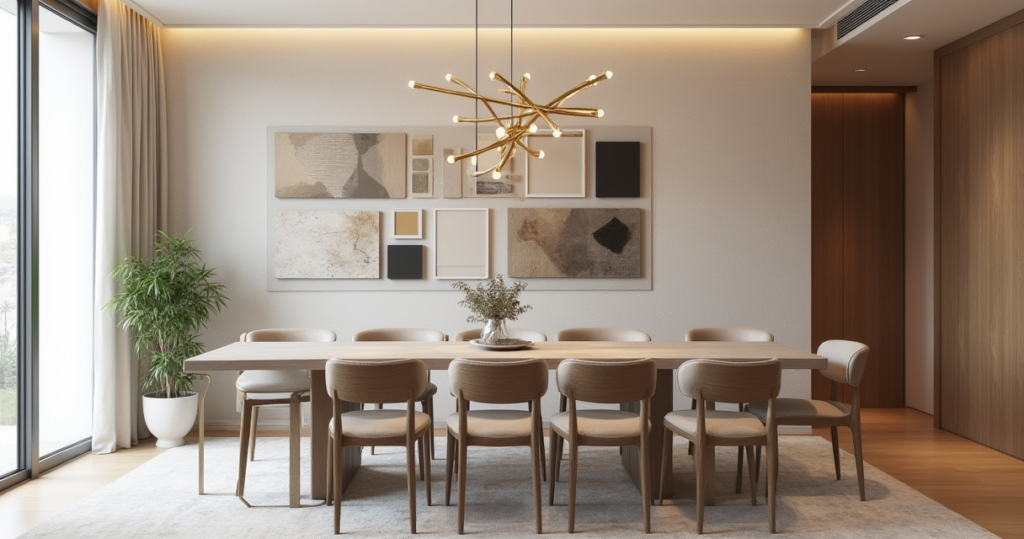Can we talk about the great British tragedy of the dining room? For decades, it’s been the forgotten space, the room “for best” that’s cordoned off with a velvet rope of parental authority, only to be used for a rather stiff Christmas lunch. It’s become a dusty museum for a table no one eats at and chairs no one sits in. And frankly, it’s a colossal waste of space and an insult to the art of gathering.
The real story is that your dining room should be the most hardworking, charismatic, and welcoming room in the house. It’s not just for eating; it’s the stage for life’s best scenes—the raucous debates, the quiet confessions, the celebratory toasts. Getting it right isn’t about following a corporate checklist. It’s about creating a backdrop that feels authentic to you and makes your guests want to linger long after the port has been finished. Here’s how we fix it.
Foundations: Vision & Spatial Planning
Before you so much as glance at a paint swatch, we need to sort out the room’s grammar. Every space has one, dictated by its light, its size, and its bones. Get this right, and everything else falls into place with the satisfying click of a well-made locking mechanism. This is the part that feels like homework, I know, but skipping it is the fastest route to an expensive mistake.
1. Define Your Signature Style: Modern, Classic, or Eclectic Harmony.
People get so knotted up about ‘style.’ They see a lovely room in a magazine and think they must replicate it precisely, only to find it feels utterly alien in their own home. Your dining room’s style isn’t something you choose; it’s something you excavate. Are you a “Downton Abbey” formalist with a love for mahogany and damask, or more of a Bloomsbury Group bohemian with mismatched chairs and walls lined with books? The answer is already in your wardrobe, your library, and the places you love to visit.

Forget what’s trending. Start a ‘mood board’—or as I prefer to call it, a scrapbook for grown-ups—and be promiscuous. Pin everything that gives you a little thrill, without judgement. After a week, you’ll see a pattern. It might be the warm minimalism of a Shaker cottage, the jewel-box drama of a Sir John Soane interior, or the lived-in comfort of a Cotswolds farmhouse. This isn’t about creating a theme park; it’s about establishing your home’s point of view. A client of mine realised her entire board was filled with images of old Italian villas. We painted her London dining room a warm terracotta, hung antique botanical prints, and suddenly, this chilly Victorian room felt like a sun-drenched escape. It finally made sense.
Once you know what you’re trying to say, you must ensure the room can actually accommodate the conversation.
2. Assess Room Dimensions Accurately: Ensure Comfortable Movement and Flow.
This sounds terribly dull, I admit, but getting the measurements wrong is the interior design equivalent of turning up to a black-tie event in hiking boots. It’s just fundamentally incorrect. The goal is to create a room that allows for the graceful dance of dining: pulling out a chair without knocking a vase, serving a dish without breathing down someone’s neck, and excusing oneself without causing a domino effect of scraped shins.
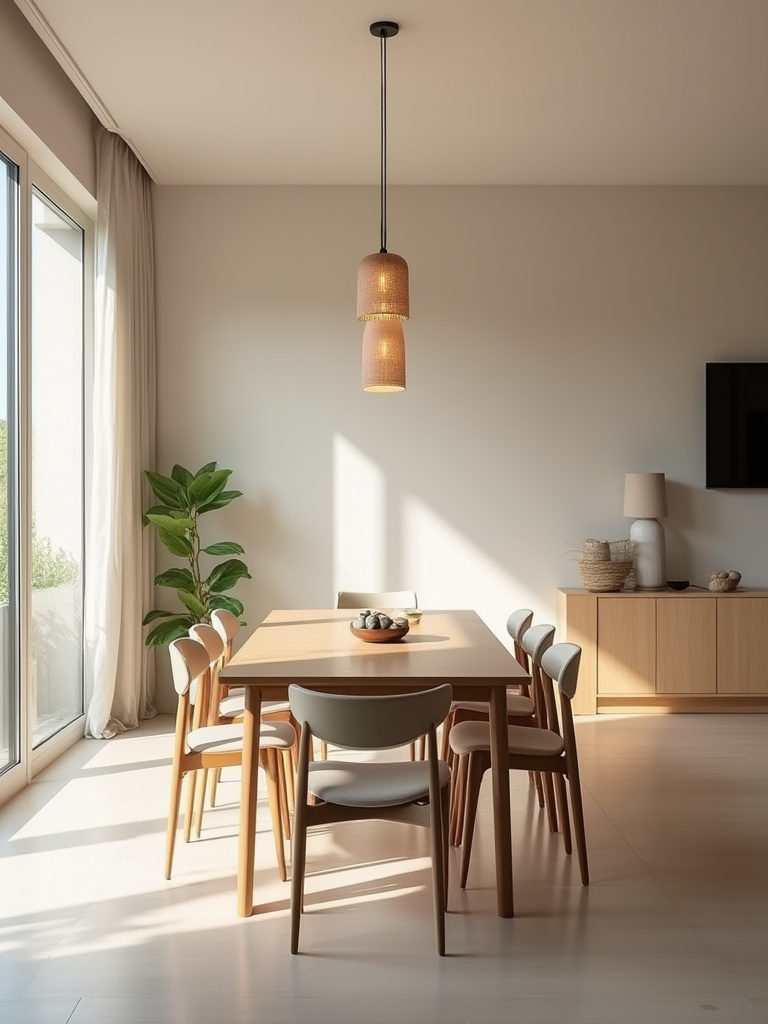
The absolute non-negotiable rule is to leave about a metre of “breathing room” between the edge of your table and any wall or piece of furniture. Less than that, and your guests will feel pinned in like sardines. Get out your measuring tape and be ruthless. Sketch a little map. Note the doorways, the swing of the door, the awkward radiator. Then, use painter’s tape to mark out the footprint of a prospective table. Live with it for a day. Walk around it. You’ll learn more from that simple exercise than from a hundred online furniture simulators.
Now that we know the physical constraints, we can begin to paint the picture.
3. Select a Cohesive Color Palette: Instantly Set the Desired Mood.
Colour is the quickest way to write the room’s emotional story. Do you want it to feel dramatic and intimate, like a conspiratorial whisper after dark? Go for a deep, inky blue or a rich green. Do you want it to feel bright, lively, and full of conversation? Perhaps a warm stone or a sunny ochre. In Britain, we have to contend with our famously grey light, which can turn a lovely pale grey into a depressing battleship drab in the blink of an eye. Always, always test your colours on the actual wall.

The BS everyone tells you is to paint small rooms a light colour. Nonsense. Sometimes, the bravest thing you can do with a small dining room is lean in and paint it a dark, moody colour. It creates a ‘jewel box’ effect that feels incredibly sophisticated and intentional, particularly at night when lit by candles and soft lamps. A famous paint maker once told me, “Dining rooms are for evening; they can handle the drama.” He was absolutely right. A deep claret on the walls can feel far more expansive and luxurious than a timid off-white ever could.
With the mood set, it’s time to pay respect to your elders—the architectural ones, that is.
4. Integrate Existing Architectural Features: Enhance Natural Beauty and Character.
So many people try to fight the architecture of their homes. They want to put stark minimalism into a wonky Tudor cottage or fussy Victoriana into a clean-lined modern build. It rarely works. Your home’s original features—the fireplace, the sash windows, the cornicing—are not obstacles. They are gifts. They are the narrative hooks that make your home unique, so for heaven’s sake, don’t ignore them.
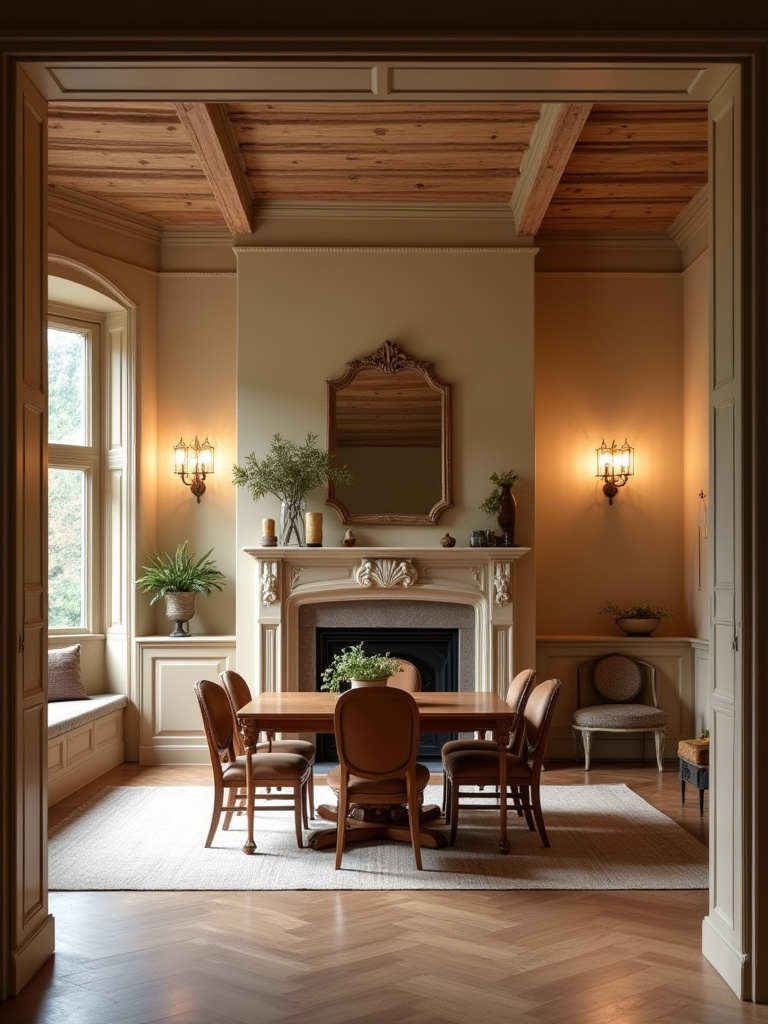
A handsome Georgian fireplace doesn’t need much—just clean it up and hang a striking mirror or a bold piece of modern art above it. The contrast will make both elements sing. If you have lovely high ceilings and ornate cornicing, draw the eye up with a magnificent chandelier. A client of mine had a built-in china cabinet that felt rather dated. Instead of ripping it out, we painted the interior a shocking Yves Klein blue. It instantly transformed a frumpy feature into a brilliant, contemporary showcase for her white ceramics. Work with the bones of your house, not against them.
Core Elements: Furnishings & Layout Mastery
Now for the main event: the furniture. This is where the room truly takes shape. The key here is not just to fill the space, but to arrange the key players—the table, the chairs, the rug—in a way that feels both elegant and effortless.
5. Choose the Ideal Table Shape: Optimize Seating Capacity and Room Flow.
The shape of your table dictates the entire social dynamic of a meal. A long, rectangular table feels grand and formal—perfect for a bit of hierarchical pageantry, like a scene from The Crown. A round table, on the other hand, is wonderfully democratic. Everyone can see and hear everyone else; it’s the shape of conspiracies, intimate debates, and shared laughter. An oval table is a brilliant compromise, offering the generosity of a rectangle with the sociability of a circle.
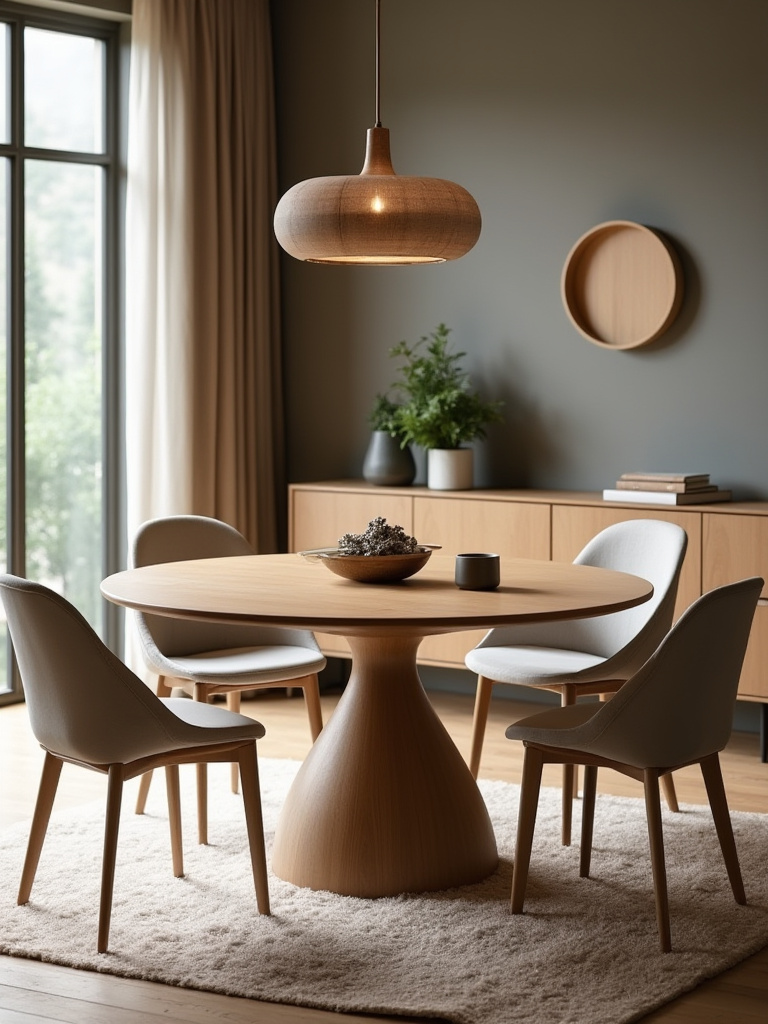
Honestly, the room usually tells you what it wants. A long, narrow Victorian dining room is crying out for a rectangular table. A square-ish room or a cosy nook is almost always better served by a round one, as it eliminates those sharp corners that become hip-bruising obstacles in a tight space. A friend of mine insisted on a massive rectangular table for her small London flat. Her dinner parties felt like navigating an obstacle course. She finally swapped it for a round pedestal table, and the space was transformed. Suddenly, the room could breathe, and so could her guests.
Of course, a table is nothing without its companions.
6. Select Chairs for Comfort and Style: Elevate the Seating Experience.
This is my single most important piece of advice: a dining chair must be comfortable. I don’t care if it’s a priceless antique or a marvel of modern design. If it makes your guests fidget after twenty minutes, it has failed. The best dinner parties are the ones that linger, where conversation flows as freely as the wine. That simply will not happen if everyone has a numb backside.
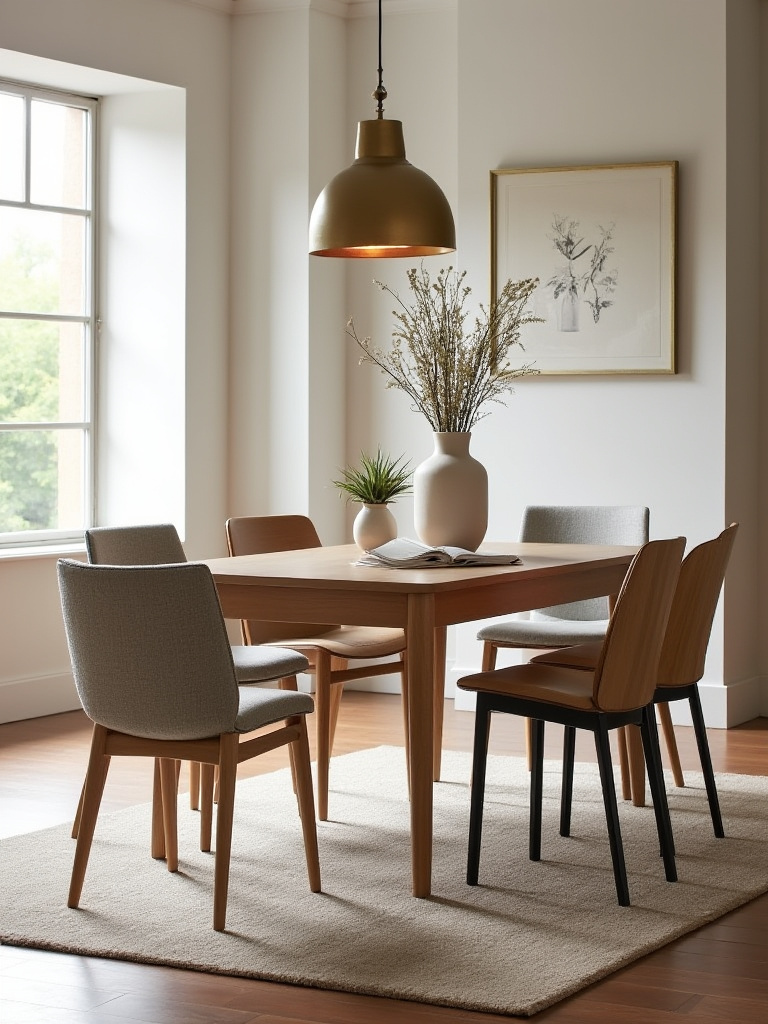
When I was just starting out, I worked for a very grand designer who specified some achingly beautiful but brutally hard Italian metal chairs for a client. The client hated them. We ended up having them all upholstered with a thin but dense foam pad covered in horsehair and velvet. It saved the day and taught me a lesson I’ve never forgotten: test every chair yourself. Sit in it. Wiggle. Imagine you’re two hours into a fabulous meal. Can you still feel your legs? If not, it’s not the one. Mixing styles can also be fabulous—an old farmhouse table with sleek modern chairs, for instance—but comfort must be the thread that ties them all together.
Now that we have the pieces, let’s get the proportions right.
7. Determine Optimal Dining Set Scale: Balance Furnishings Proportionally.
This is the Goldilocks principle of design. Not too big, not too small, but just right. A hulking, baronial dining set in a modest room feels oppressive and arrogant. A tiny, delicate set in a vast, open-plan space looks lost and pathetic, like a lifeboat in the middle of the ocean. The furniture must be in conversation with the scale of the room.
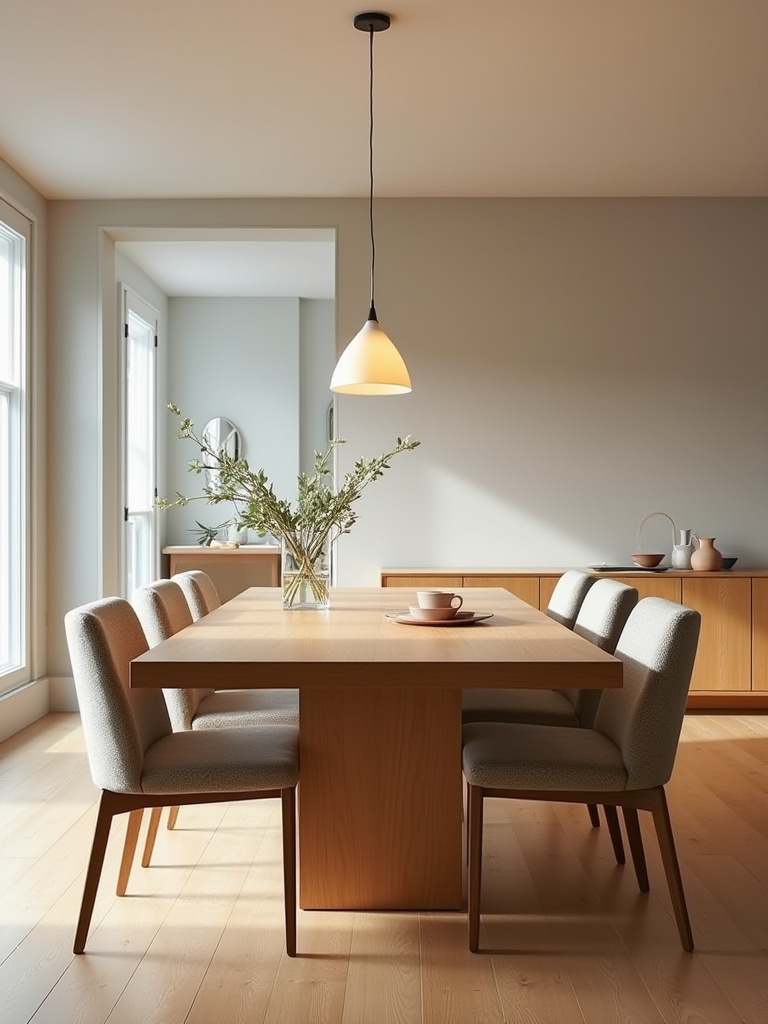
The shortcut here is to think visually, not just numerically. Before you buy anything, mock it up. You can use a bedsheet folded to the size of your proposed table, and place cardboard boxes where the chairs will go. It sounds silly, but it gives you an immediate, tangible sense of the volume the furniture will occupy. I once saved a client from buying a gargantuan American dining table for his elegant but modestly proportioned Georgian townhouse. We mapped it out with newspaper on the floor, and he saw instantly that it would have left no room for life. We found him a slender Hepplewhite-style table instead, and it looked perfect.
With the primary furniture scaled correctly, it’s time to define its territory.
8. Anchor the Room with a Statement Rug: Define the Dining Zone Visually.
A rug in the dining room is not just a rug. It is a stage. It defines the space, grounds the furniture, and signals to everyone that this is where the action happens. This is particularly crucial in an open-plan living area, where a rug can create a distinct ‘room’ without needing any walls. It also adds a layer of softness, absorbs sound, and feels lovely underfoot.
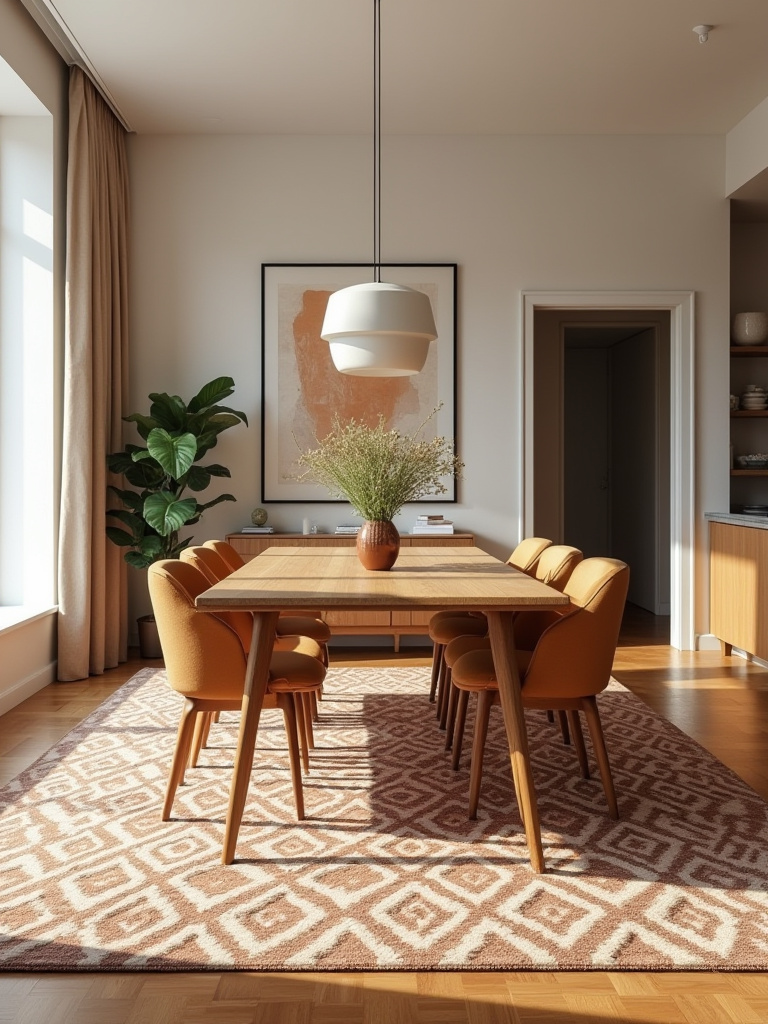
The cardinal sin is buying a rug that is too small. I see it all the time. The dining chairs should still be fully on the rug even when they are pulled out from the table. If the back legs catch on the edge of the rug every time someone gets up, you’ve failed. Measure your table, add at least 60 centimetres to every side, and that’s your minimum rug size. As for material, don’t be a hero. This is a high-spill zone. A low-pile wool or a durable flatweave is your friend here. Leave the priceless silk Persian for the bedroom.
Once the stage is set, you need to choreograph the movement.
9. Arrange Furniture for Seamless Traffic Flow: Optimize Guest Movement and Interaction.
A well-designed room has an invisible choreography that guides you through it. In a dining room, this is paramount. You need a clear, unimpeded path from the door to the table, and most importantly, from the kitchen to the table. Nothing sours the mood of a dinner party faster than a host who has to perform a Cirque du Soleil routine just to serve the soup.
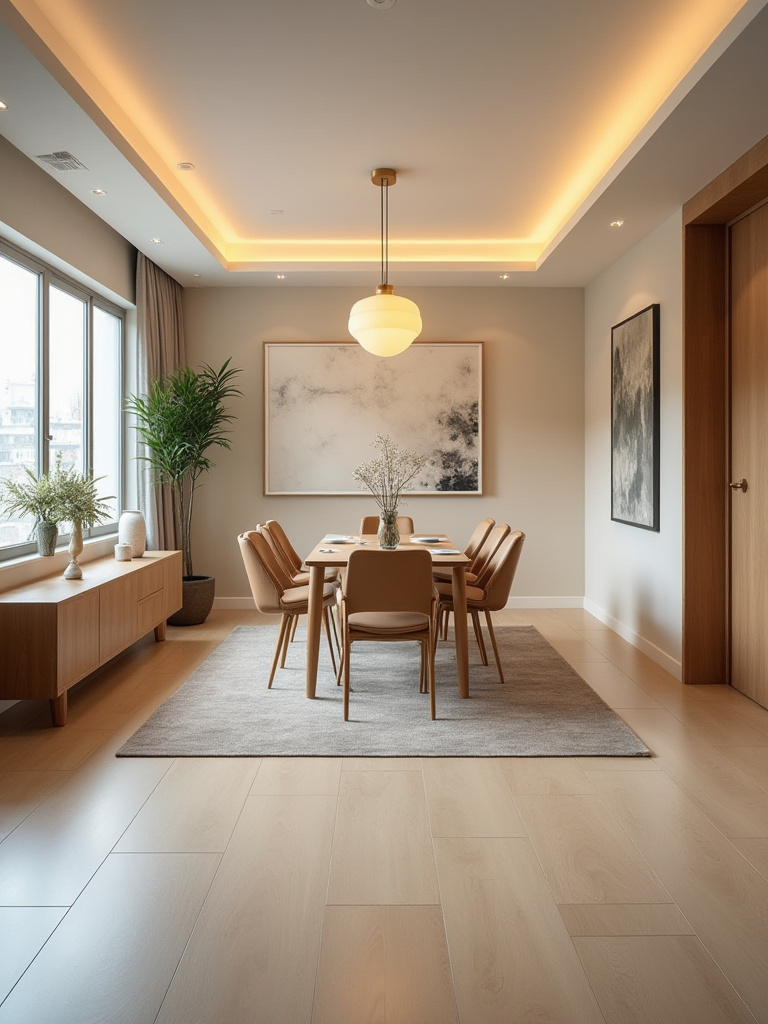
The key is to place your largest ancillary piece—usually a sideboard or a console—against the longest wall that is not part of a major traffic route. Keep it lean. A beautiful sideboard is a godsend for storing linens, cutlery, and extra glassware, and for serving as a buffet. But if it juts out into the room and creates a bottleneck, it’s doing more harm than good. Keep paths clear, keep movement fluid, and your evenings will be far more serene.
Ambiance Amplifiers: Lighting & Textiles
This is where the real magic happens. The furniture and layout are the grammar, but lighting and textiles are the poetry. They set the mood, add the texture, and transform a functional room into an atmospheric one.
10. Install Layered Lighting: Achieve Versatile Mood Settings and Practicality.
Can we please declare a war on the single, central overhead light? It is the enemy of all good atmosphere. It casts harsh, unflattering shadows, makes everyone look tired, and gives the room all the charm of a doctor’s waiting room. The secret to beautiful lighting is to layer it. You need multiple sources of light that you can control independently.
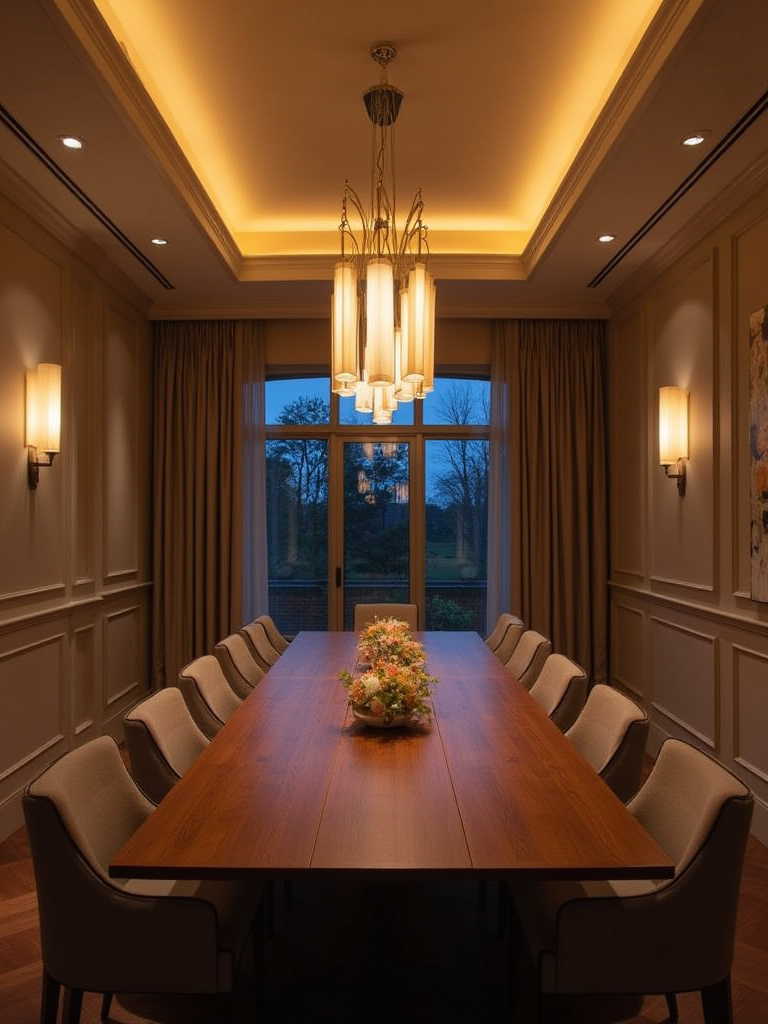
Think in three layers. First, ambient light: your general, room-filling light. This could be a chandelier, but it must, must, must be on a dimmer. Second, task light: this is your focused light. In a dining room, this is often the same as your ambient light, but you might also have lamps on a sideboard. Third, and most importantly, accent light: this is the secret sauce. Think picture lights over art, tiny uplighters behind plants, and—of course—candles. A room lit only from above is flat. A room lit from multiple angles has depth, mystery, and soul.
Getting the layers in place is only half the battle; positioning them correctly is the other.
11. Position Main Fixtures Correctly: Illuminate Your Dining Table Evenly.
Your main light fixture—be it a grand chandelier or a sleek modern pendant—should be centred over the table, not necessarily over the centre of the room. This anchors the dining area as the focal point. And the height is crucial. It needs to be low enough to create a pool of intimate light over the table, but not so low that it blocks sightlines or you risk head-butting it when you stand up.
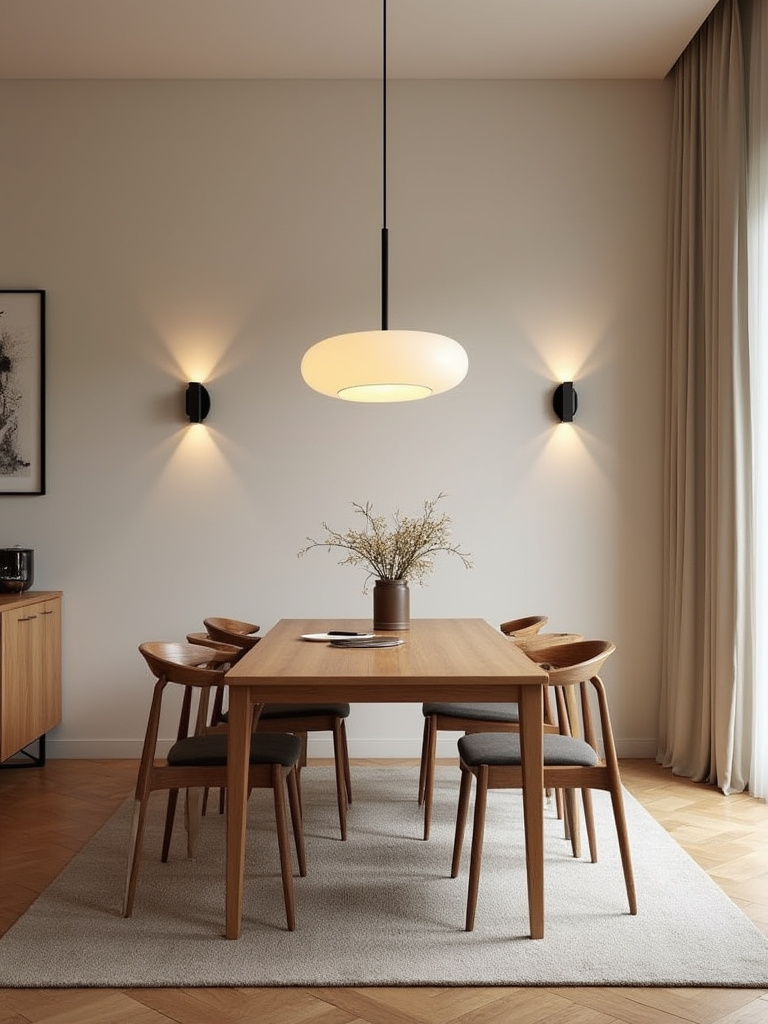
A good rule of thumb is to hang the bottom of the fixture about 75 to 90 centimetres above the tabletop. Live with it for a bit before you have the electrician make the final snip. Have a friend sit opposite you. Can you see them? Is the light in your eyes? It’s a simple test, but an essential one. I once had to mediate a rather heated domestic dispute over the height of a chandelier. We lowered it by a mere ten centimetres, and suddenly, harmony was restored. It’s that important.
And now for the non-negotiable tool that brings it all to life.
12. Utilize Dimmer Switches: Adjust Brightness for Any Occasion Instantly.
If you do only one thing from this entire list, let it be this: install dimmer switches on every single light in your dining room. Every single one. It is the single most effective, and relatively inexpensive, way to control the atmosphere of a room. Without a dimmer, you have only two options: on or off. That’s not atmosphere; it’s a binary choice.
With a dimmer, you can dial the light down to a soft, flattering glow for an intimate dinner, or turn it up for family game night or when you’re cleaning. I consider a dining room without dimmers to be fundamentally unfinished. It’s like owning a magnificent sports car and only being able to drive it in first gear. It’s a tragic waste of potential.
With the lighting perfected, we turn to the final layer of softness and sophistication.
13. Select Linens and Textiles Wisely: Enhance Tabletop Comfort and Visual Appeal.
Textiles are what separate a dining room from a cafeteria. The weight of a good linen napkin, the soft drape of a tablecloth, the subtle texture of a runner—these things add a sensory depth that makes a meal feel like an occasion. It tells your guests that you’ve made an effort, that you care about their comfort.
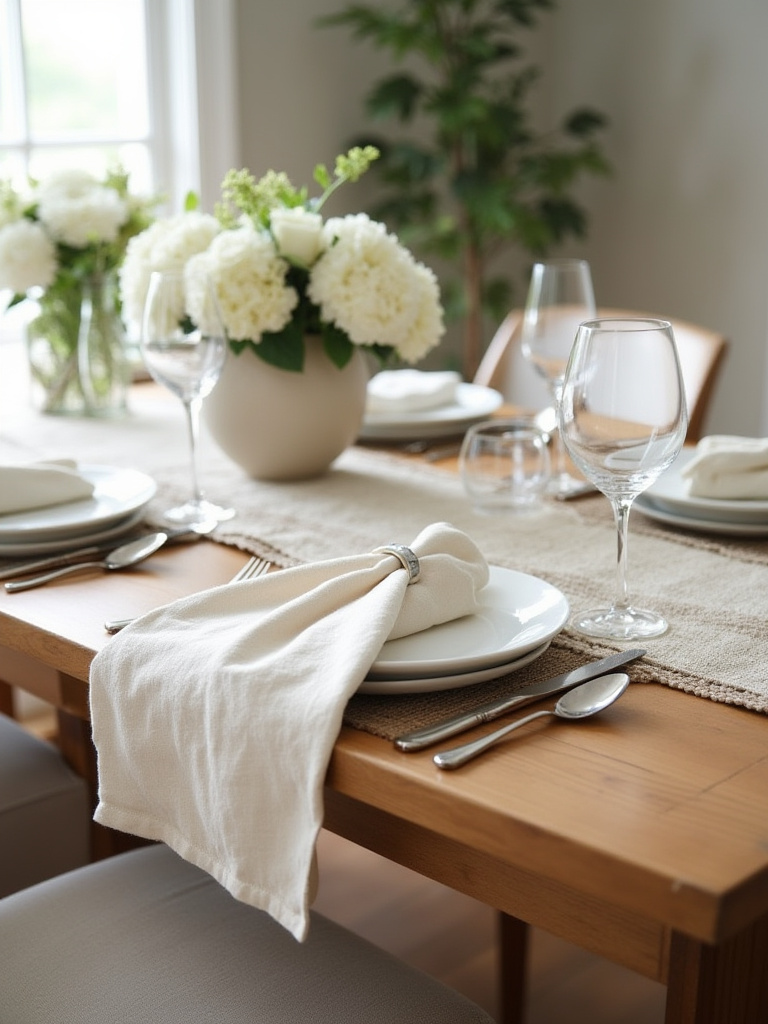
You don’t need a full-blown tablecloth for every meal, of course. Sometimes the natural beauty of a wooden table is all you need. But a simple linen runner can ground a centrepiece, and well-made placemats can define each person’s space beautifully. I have a collection of antique Irish linen tablecloths that I adore. They are a nightmare to iron, but the way they feel and the way they catch the candlelight is worth every single second of labour. Invest in quality natural fibres—linen, cotton, wool. They only get better with age.
Detailing & Personalization: The Finishing Touches
The room is furnished, lit, and comfortable. Now it’s time to give it a soul. These are the final flourishes that make the space uniquely, unmistakably yours.
14. Curate Meaningful Wall Art: Express Your Personality Visually and Boldly.
Please, I beg you, do not buy generic “art” from a big-box store just to fill a wall. Art is not just decoration; it is the visual manifestation of your story. It should mean something to you. It could be a painting by a local artist you admire, a series of architectural prints from a city you love, or even your own children’s artwork, beautifully framed. A gallery wall of mismatched family photos in cohesive frames can be incredibly charming.
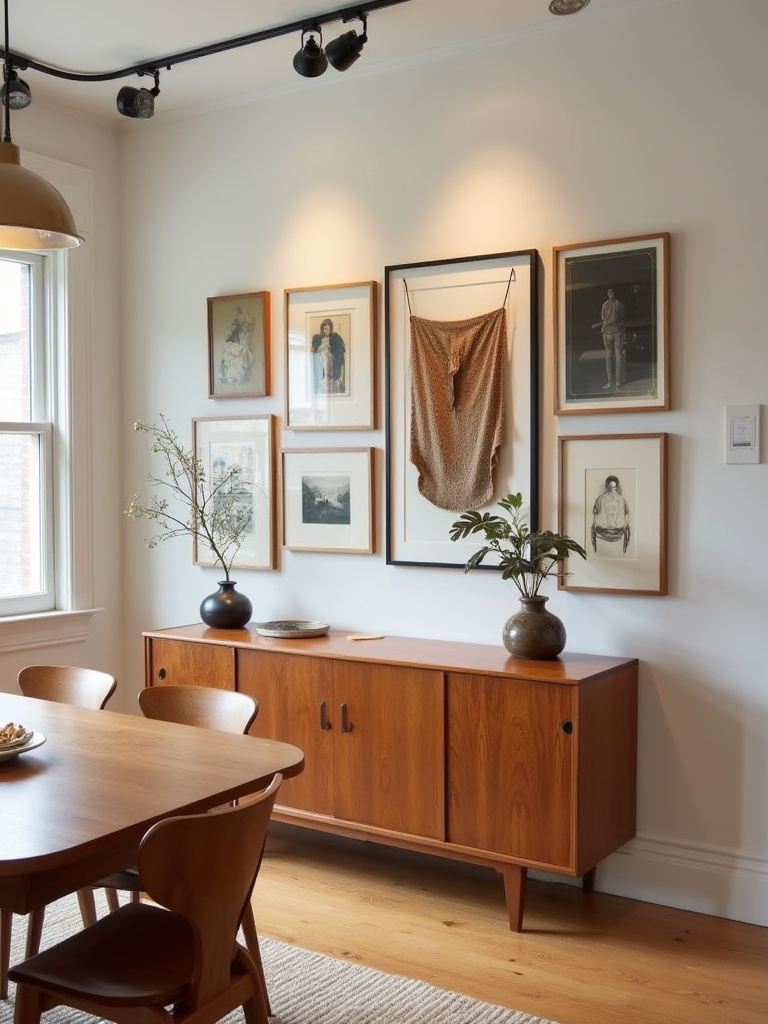
A very chic client of mine, who couldn’t afford expensive paintings, bought a book of 18th-century botanical illustrations from a flea market, carefully cut out the pages, and had them all framed identically. They filled an entire wall, and the effect was absolutely breathtaking—far more personal and impactful than one expensive but soulless abstract painting could ever have been. Your walls are an opportunity to say something interesting. Don’t waste it on gibberish.
Now, let’s bring that personal touch down to the table itself.
15. Select Themed Centerpieces: Add Seasonal or Event-Specific Flair Effortlessly.
The word ‘centrepiece’ can conjure up terrifying images of stiff, formal floral arrangements. Let’s redefine it. A centrepiece is simply a focal point for your table that reflects the mood or the season. It shouldn’t be a permanent fixture, but a living, evolving element. And for goodness sake, make sure people can see over it.
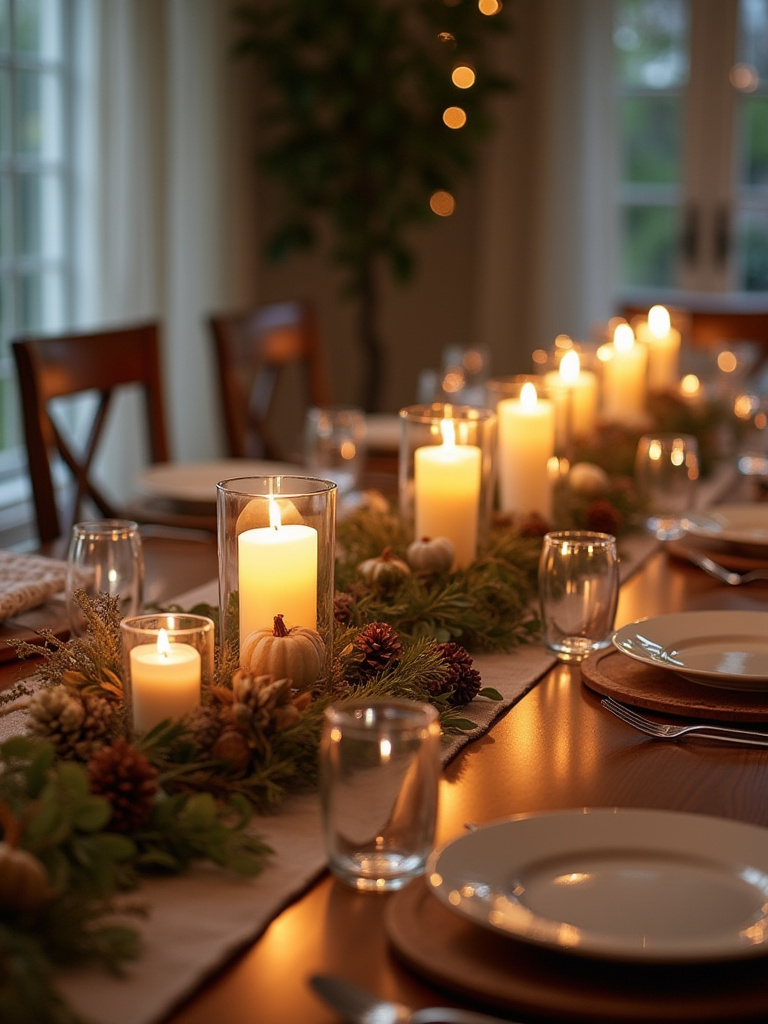
In autumn, a beautiful wooden bowl filled with moss, small gourds, and pinecones is stunning. In winter, a simple line of pillar candles of varying heights nestled in a bed of evergreen branches is magical. In spring and summer, forget the formal florist. A collection of small jam jars, each with a single stem from the garden—a rose, a sprig of lavender, a cosmos—can look far more charming and effortless than a rigid bouquet. The key is to keep it low, organic, and personal.
Complementing your centerpiece with a touch of life is always a brilliant move.
16. Integrate Greenery for Freshness: Bring Nature’s Calming Touch Indoors.
Every room needs something living in it. It’s a design rule as old as time. A plant—or even just a few cut branches in a vase—brings life, freshness, and a connection to the outdoors that prevents a room from feeling stale or overly decorated. They soften hard edges and add a sculptural, organic quality that man-made objects just can’t replicate.
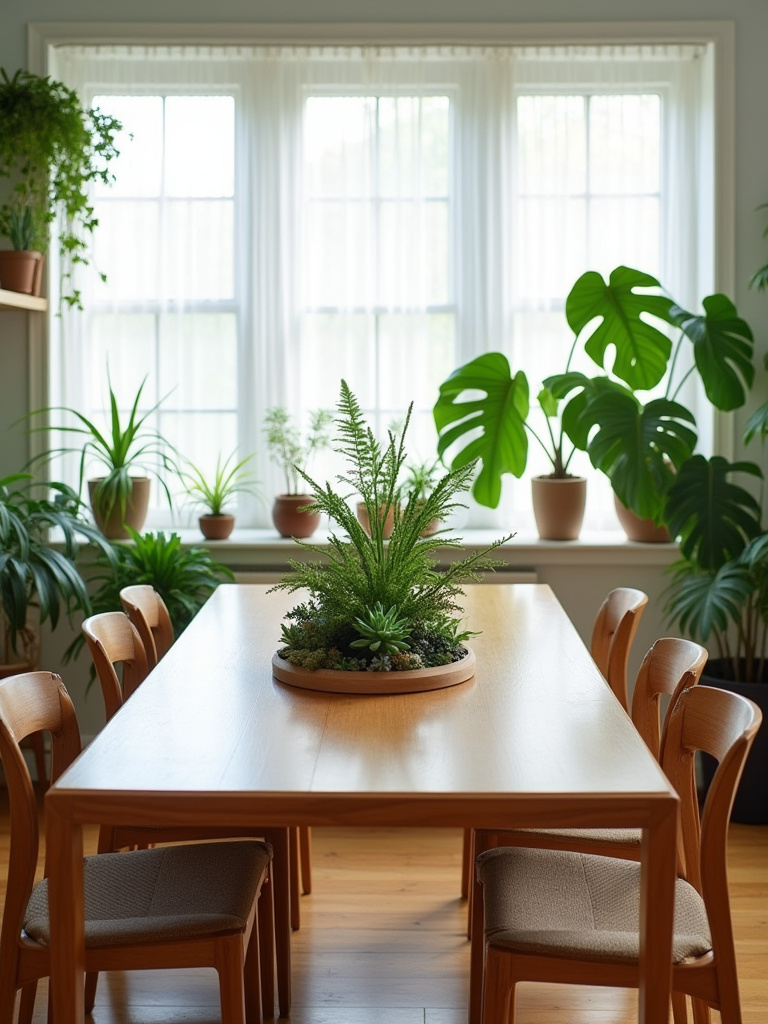
Even if you have the opposite of a green thumb, there are options. A sculptural sansevieria (snake plant) thrives on neglect. A large fiddle-leaf fig can make a magnificent statement in a bright corner. For a long table, a row of small potted ferns can be a wonderfully architectural and long-lasting alternative to flowers. I learned this trick from a designer who worked on country estates; he would bring in enormous branches of beech or oak and place them in a giant floor vase. The effect was incredibly dramatic and cost absolutely nothing.
Now, let’s play with light and space in a clever, almost theatrical way.
17. Incorporate Reflective Surfaces: Amplify Light and Create an Expansive Feel.
This is an old trick, but it’s one of the best. The great architect Sir John Soane was a master of using mirrors to cheat space and manipulate light in his London home, and the principle holds true today. A large, well-placed mirror can visually double the size of your room, amplify candlelight into a magical glow, and reflect a beautiful view from a window.
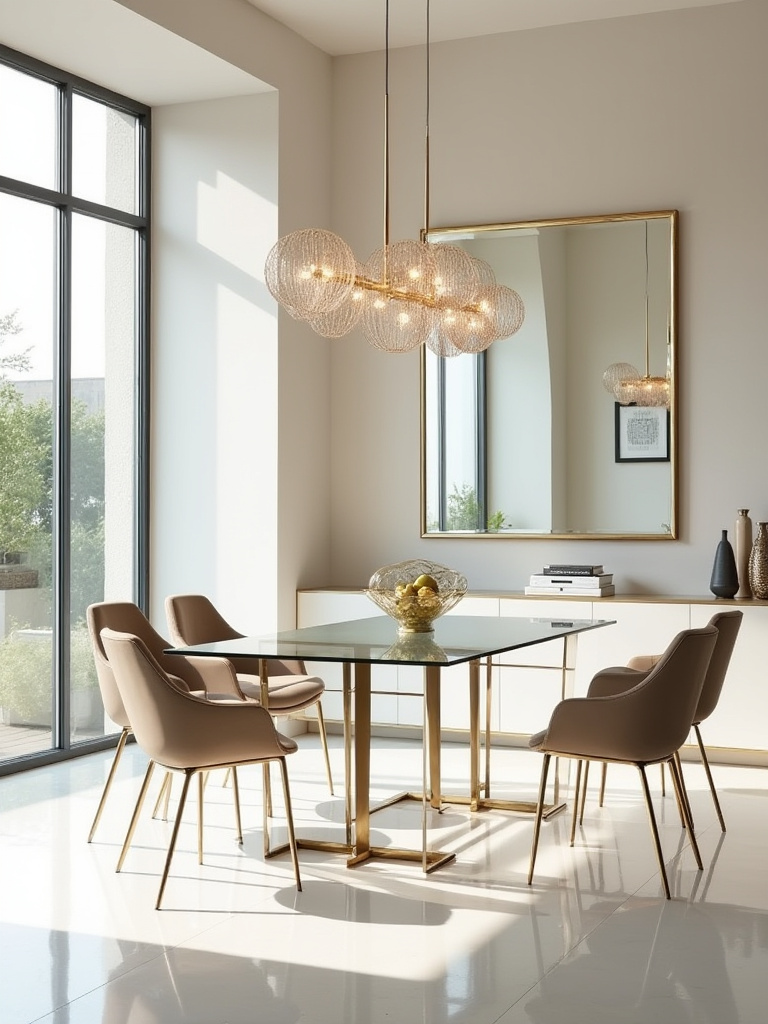
You don’t have to turn your dining room into a hall of mirrors. It’s about strategic placement. A large mirror over a sideboard or fireplace is a classic for a reason. But also think about other reflective surfaces: a polished silver water jug, a grouping of crystal decanters, a brass-framed piece of art. These small touches catch the light and add a subtle sparkle that brings the room to life, especially in the evening.
Your beautiful objects shouldn’t just sparkle—they should earn their keep.
18. Choose Serveware as Decor: Display Beautiful Dishes Aesthetically.
Why hide your grandmother’s beautiful china or your collection of colourful Moroccan tagines in a cupboard? Your serveware can be a key part of your decor. Displaying beautiful plates, pitchers, and platters adds personality, colour, and texture to the room. It suggests that this is a home where people actually gather and share food, not just a showpiece.
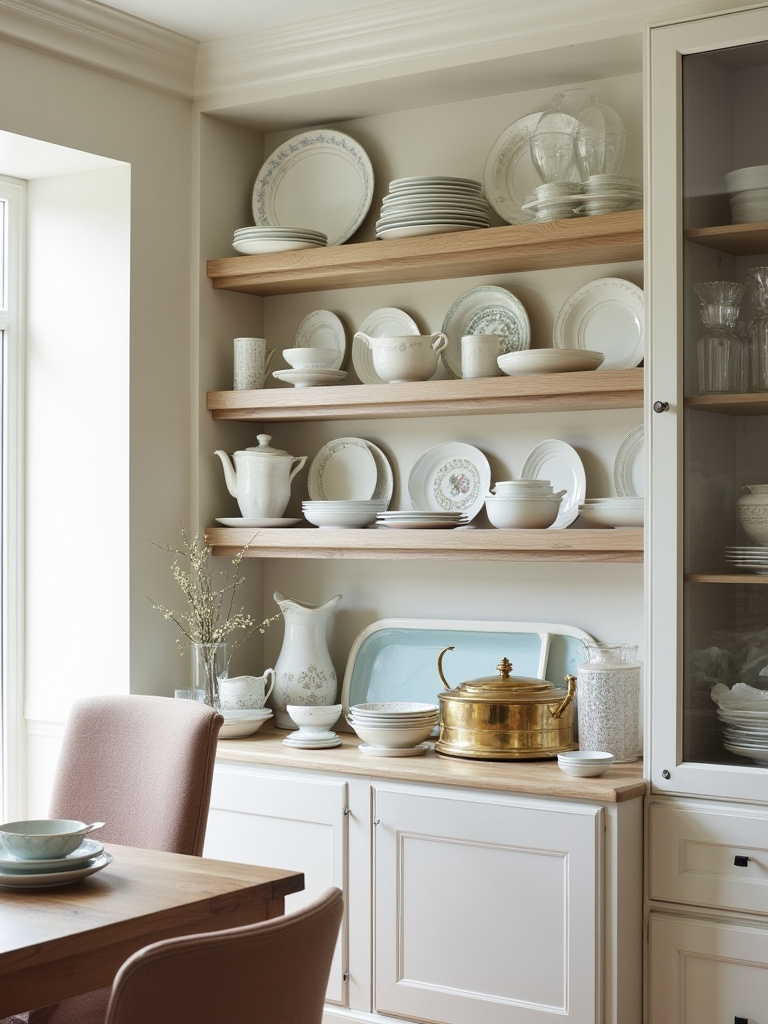
A classic Welsh dresser is perfect for this, but so are simple, open shelves. Stack plates, lean platters against the wall, group pitchers of similar colours together. I once worked on a very minimalist dining room that felt a bit cold. The owner had an incredible collection of blue and white Spode china. We installed three long, floating shelves and arranged the entire collection on them. It became a stunning, deeply personal feature wall that warmed up the entire space instantly.
Finally, with all these beautiful things in place, we need a strategy for keeping it all looking sharp.
Refinement & Long-Term Appeal: Maintaining Beauty
A beautiful dining room isn’t a static creation. It’s a living space that needs a bit of care and attention to stay at its best. This is about ensuring your hard work endures and the room remains a place of effortless elegance, not a source of stress.
19. Add Discreet Storage Solutions: Maintain Clutter-Free Elegance Easily.
Clutter is the death of elegance. And dining rooms, if you’re not careful, can become magnets for it—the mail, the school projects, the half-finished bottle of wine. Good, discreet storage is not a luxury; it is a necessity for maintaining your sanity and the room’s sophistication.
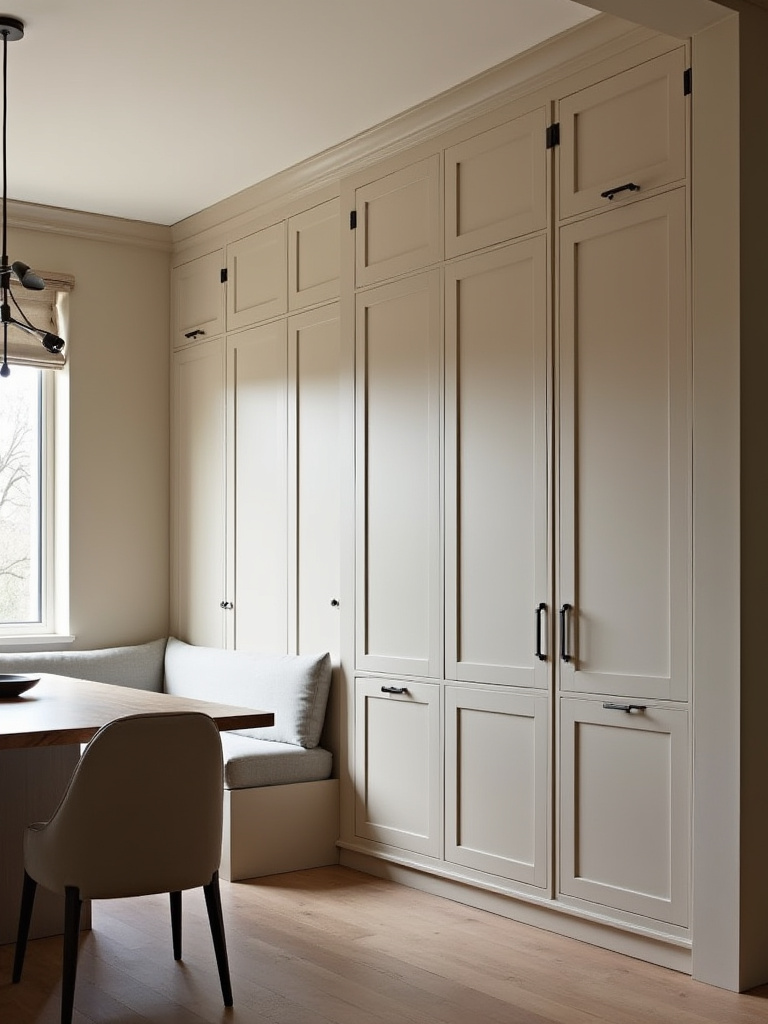
A beautiful sideboard or credenza is your best friend here. It provides a home for everything from table linens and candles to that ridiculously oversized platter you only use once a year. If you’re tight on space, a banquette with a lift-up seat or built-in drawers is an ingenious solution. The goal is to have a place for everything, so that the surfaces—the table, the sideboard top—can remain beautifully clear and ready for action at a moment’s notice.
Once the physical clutter is managed, let’s address the auditory kind.
20. Consider Acoustic Treatments: Improve Dining Conversation Clarity and Comfort.
This is the secret weapon of truly great dining spaces, and it’s something almost everyone overlooks. Have you ever been in a restaurant with so many hard surfaces—bare floors, bare walls, bare tables—that the noise level is deafening? It’s exhausting. The same can happen in your home. Sound bounces off hard surfaces, creating a clatter and echo that makes conversation a strain.
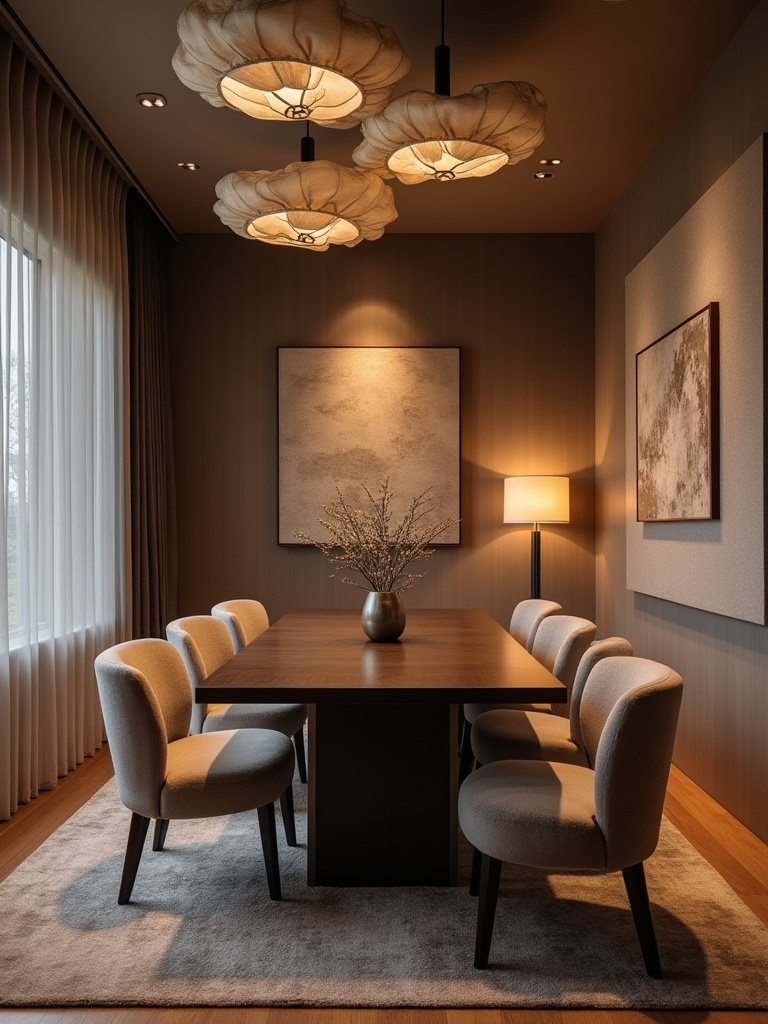
You don’t need to install professional acoustic panels (though they can be disguised as art). The solution is simply to add soft things. A rug is your first line of defence. Upholstered dining chairs make a huge difference. Heavy curtains, a fabric wall hanging, even a tablecloth—all of these things absorb sound and create a calmer, more intimate atmosphere where you don’t have to shout to be heard.
With the room feeling serene, keep it looking interesting.
21. Rotate Decorative Elements Seasonally: Keep the Aesthetic Fresh and Engaging.
A room that never changes can become boring, almost invisible. Rotating a few key elements with the seasons keeps your dining room feeling fresh, alive, and connected to the world outside. It doesn’t have to be a major overhaul. It’s about small, thoughtful swaps.
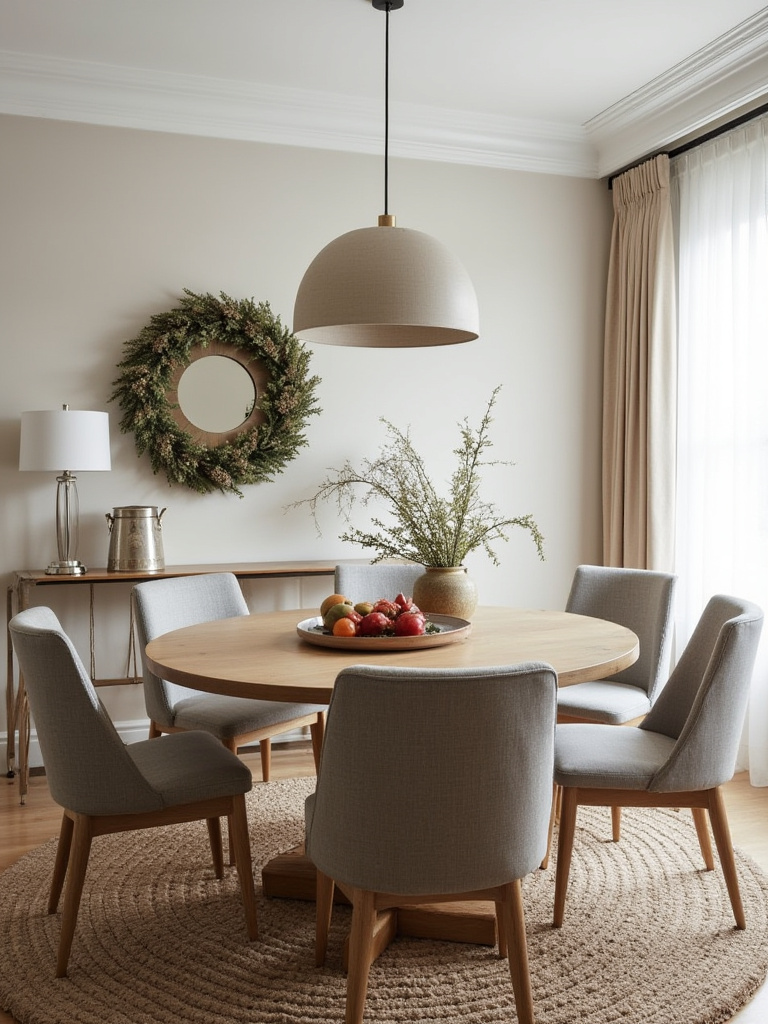
In spring, you might bring out your pale green linen napkins and fill a vase with tulips. In summer, maybe it’s bright, patterned placemats and a bowl of lemons. In autumn, switch to earthenware plates and plaid wool throws on the chairs. This simple ritual makes you look at your room with fresh eyes, appreciate what you have, and prevents the space from ever feeling stale.
This leads to the final, and perhaps most crucial, habit of all.
22. Perform Regular Decluttering: Preserve a Polished and Inviting Look Effortlessly.
This is the most important discipline of all. It’s not about dramatic purges; it’s about constant, gentle editing. The dining table is not a desk. The sideboard is not a post office. The chairs are not wardrobes. A quick, five-minute sweep at the end of each day to put things back in their rightful homes is all it takes to prevent the slow creep of clutter.
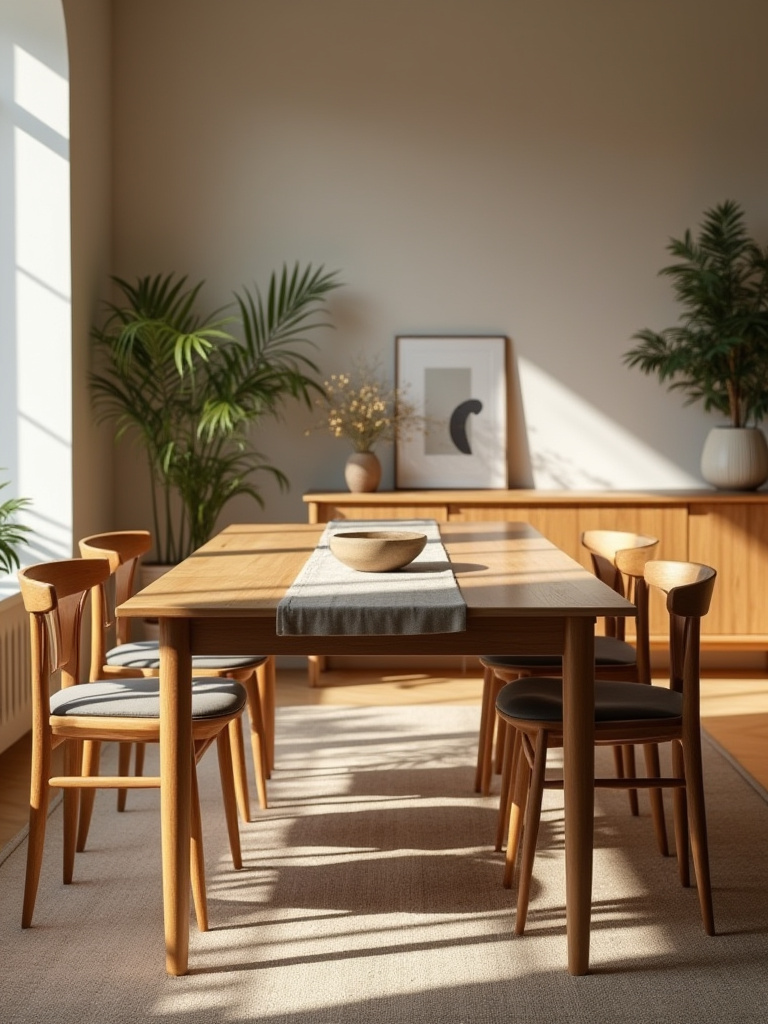
I am a firm believer in the “one in, one out” rule for decorative objects. If you buy a new vase, an old one must be retired. This prevents the dreaded ‘surface-clutter syndrome,’ where every flat space becomes crammed with knick-knacks. The great designer William Morris famously said, “Have nothing in your house that you do not know to be useful, or believe to be beautiful.” This should be your mantra.
Conclusion
So there you have it. Your dining room is not just another square on the floor plan. It is the heart of your home’s social life, a place where the simple act of breaking bread becomes a ritual of connection. By paying attention to its foundations, choosing its contents with care, layering its atmosphere with light and texture, and tending to it with gentle discipline, you transform it from a neglected space into a room that is truly alive.
Don’t be daunted. Start with one thing. Install a dimmer switch. Buy a comfortable chair. Frame a meaningful picture. Each small act builds on the last, until one day you’ll look around and realise you’ve created a dining room that not only looks stunning but feels like home. A room that invites people to pull up a chair, to raise a glass, and, most importantly, to stay a while.
